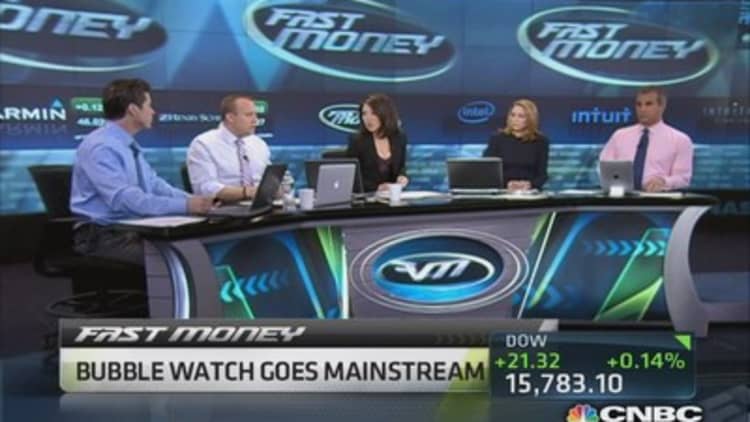More often than not, since the financial crisis began the stock market has been a real turkey around Thanksgiving.
The S&P 500 has been positive in only two of the last six years in the two weeks before Thanksgiving, with dramatic losses in some of the other years. Over the last six years, the average performance for the two-week period has been a negative return of 1.8 percent for the S&P.
(Read more: The deceptively simple reason stocks won't quit)
However, historically the market tends to trade higher before Thanksgiving and for November as a whole. Since 1980, the S&P 500 was higher more than two-thirds of the time in the two-week period before Thanksgiving.

This year could be positive, with many analysts expecting stocks to ride an uptrend into year end, boosted by seasonal factors amid a lack of major hurdles.
"There's an old saying: the bears have Thanksgiving but the bulls have Christmas," said Sam Stovall, chief U.S. equity strategist at S&P/Capital IQ. But statistics show that, on average since 1945, November has been the fourth-best-performing month of the year, returning an average 1.3 percent, according to S&P.
Thanksgiving – which falls on November 28 this year – comes amid an active debate about how much longer the market can run before seeing a substantial correction. But many analysts say if the market pulls back before year end, it will only be mild, since dip buyers should jump in.
"Thanksgiving seasonality had been historically where it used to be the Wednesday before and the Friday after were pretty strong, but what we're finding more recently is it's best to get into the market if you're going to be short-term trading in the weakness the week before and sell into the strength just prior to or after Thanksgiving," said Jeff Hirsch, publisher of the "Stock Trader's Almanac." "It doesn't always come in the same place. It's not cut and dry."
(Read more: Chicago ratings cut: Should investors be worried?)
While up just 0.2 percent in the past five sessions, the S&P 500 was trading just below its all-time closing high Tuesday. It ended Monday, up 1 point at 1771.89, while extended its record run, climbing 21 points to a new high of 15,783.
"I wouldn't mind seeing the market consolidate here and then be ready for some acceleration," said Tom Lee, JPMorgan's chief U.S. equity strategist. There could be a slight pullback by the end of the year, with the S&P possibly dipping back to 1,700, Lee added. "I think we could see something like that; it could be an entry point."
LPL Financial chief market strategist Jeff Kleintop, in a note Monday, pointed to an important trend that could continue to support the stock market's gains. Kleintop said the expected great rotation to stocks from bonds may be underway, based on fund flow data that showed one of the biggest monthly inflows to U.S. stock funds in years in October.

Kleintop expects to see more investors move from bonds to stocks, and 2014 may be the year that individual investors return to the stock market in a big way. He pointed out that, in the last several weeks, the difference in the five-year annualized return between stocks and bonds has jumped to 10 percent from around 2 percent in August. He said the rolling five-year return appears to be the return investors have most closely followed for the stock market, based on their behavior.
"The one-, three-, and five-year trailing annualized returns are now in the double digits for the first time this cycle," wrote Kleintop. "This may prompt many investors to reconsider the role of stocks in their portfolios – especially as interest rates rise and bond performance lags."
(Watch this: Watch Art Cashin: Monitor this S&P level closely)
Stovall said it's possible stocks could see a slight pullback before year-end, but the market is also setting up for a larger correction that could be a while coming. "I think it's a possibility. There are an awful lot of stocks that are still trading below their May 22 highs, so I think people would be very interested in harvesting some tax losses since they have such gains they might want to offset," he said of a pullback. The S&P 500 is up 24.2 percent year-to-date.
Stovall said the market has now gone for 25 months without a major correction of 10 percent or more. "The average time span has been 18 months, and the median has been 12 months. We're at 25 months. There have been six times since World War II that we continued to advance between six and 60 months."
As for this year, should the S&P 500 end with a more than 20 percent gain, there's a good chance it will be up double digits next year too, he said. "In the years after 20 percent gains, the S&P has risen an additional 10 percent," he noted. "Great years beget good years."
(Read more: Do Saudis have a new best friend? Don't bet on it)
Traders are also expecting a 'Santa rally,' which happens about 70 percent of the time. That is when the market rallies in the last five trading days of December and into the first two days of the New Year.
This year, Thanksgiving has the added bonus of also being the same date as Hanukkah, but that might not be positive for stocks. "Because the holidays now match up, there could be additional reason to lighten up or at least close some overly exposed positions so you can enjoy your family and not worry about the market," Stovall said.
(Read more: Where US gasoline prices are headed)
—By CNBC's Patti Domm. Follow here on Twitter @pattidomm.


